How to Grow Sorghum Without Irrigation in an Arid Environment
Sorghum is a drought tolerant relative of corn used for grain and syrup that more drought tolerant than corn, high in calories, easy to store, and easy to process at home without complicated equipment. The stalks look so much like corn it is hard to tell the difference until the seed heads emerge, though sorghum leaves are slightly darker with a silver green cast. Plant sorghum shallow, 1.5 - 2" deep or less. Sorghum takes longer to mature than corn so if the growing season is short choose fast maturing varieties like Ba Ye Qi or Gaolian Voskovidnyj. The seeds are small and harvested seed heads can be fed directly chickens without shucking or grinding. Both sorghum and corn are low in available vitamin B3 so for livestock combine with other feed us part of a balanced diet and consider using adding a vitamin B supplement to the drinking supply.


The sorghum tolerated the high pH, close planting, and poor soil conditions much better than the corn and produced as much in 4 rows as the corn did in 12 rows. We have not tried planting them deep or growing without irrigation. This was the first we have grown sorghum and have never seen it before, so it was interesting to see the stalks swell and split lengthwise and seed heads emerge. They look a little like the alien Byrum from the movie Dreamcatcher. The late planted a short white sorghum variety under the corn finished late. We pulled them out and put them in a bucket with wet soil to let the seeds finish maturation indoors. For Ba Ye Qi sorghum which is a red sorghum wait until the the heads mostly brownish red before harvest. The green close to ripe ones with swollen kernels shown in the picture below still need 1-4 weeks more before harvest.
Pests
When near ripe birds will come and peck and damage a few kernels, looser type heads make it harder for them to perch. We also had wasps which would collect in the sorghum heads overnight but they did not make nests, sting, or affect quality and yield. These wasps do the same thing in corn tassels and I suspect they are preying on small harmful insects like aphids.




Harvesting & Processing
Sorghum kernels are smaller than corn but easy to harvest. Let the sorghum dry on the stalk till brown or red and then cut the mature heads off. If needed dry a few more days. Cover a large tub with a 1/8" hardware cloth, tie it on firmly. Rub the heads pulling towards the stem till the outer kernels drop into the tub. After most of the outer kernels are gone press the head down on the hardware cloth and roll it till the inner kernels drop into the tub. Pour the kernels from one container to another in front of a fan to blow away the chaff and get clean sorghum kernels. Sorghum has a nutty taste and can be steamed like rice or ground into a flour to make various products. See our page on corn sorghum shortbread.
Sorghum Varieties and Plant Height
Mature height is a variable that should be considered when breeding and selecting the best drought tolerant varieties. I have 2 types of sorghum the larger of which Ba Ye Qi produced very well in 2022. Sorghum is more drought tolerant than corn but does not tolerate deep planting and most reports say sorghum has a shallower root system than corn. I thought sorghum would need some irrigation and didn't plant any in 2023. Another article reported that both sorghum and corn roots can extend to 10 feet deep. In considering to replant the shorter type of sorghum there is a concern that shorter plants may also have shorter roots and be less drought tolerant. A research article which demonstrated that sorghum varieties with more stem mass, as biomass reserve, were more drought tolerant and continued grain fill better under adverse conditions compared to 3 x dwarf varieties shorter than 4 feet. Not what I expected but interesting.


(Update Oct 8 2023) One stalk of sorghum sprouted in Field 2 with the corn and made a tassel but there were no filled kernels. Sorghum like corn can also grow without irrigation and we plant to do further testing of planting methods, fertilizer application, and new varieties.
New Sorghum Varieties for 2024
- White African Grain Sorghum (black glumes)
- Black Seeded Sorghum
- White Popping Sorghum
- Tarahumara White Popping Sorghum
- Texicoa Sorghum
- Korjaj Sorghum
- Kawanda Sorghum
- Allu Jola Sorghum
- M6-1 Sorghum x Johnsongrass (perennial hybrid)
- Gaolian Voskovidnyj (waxy aka starchy sorghum)
- Sorghum (landrace)
Sorghum 2024
We planted 6 types of sorghum by presprouting, drilling 3-6 inch holes, placing seed, and backfilling with 2 inches of soil but none emerged. Sorghum seeds are much smaller with fewer energy reserves compared to corn and with dry topsoil the seedlings probably die before they can reach moisture or conversely if planted deeply are unable to reach the soil surface.
Sorghum (Update Aug 26 2024) One sorghum with 5 seed heads grew where I planted the Gaolian Voskovidnyj sorghum in the Hopi Pink field. Four seed heads are developing seeds and may ripen before the first frost. This was planted by drilling a 2" hole at the bottom of a 12" furrow, hole backfilled, and then backfilled around the plant in late June when it was 2' high. At that time it was mistakenly identified as Hopi Pink corn. It is growing well without irrigation and we ordered 240 more seeds from the same source to combine together for 2025.


Sorghum 2024 / Stingless Wasps
|


Gaolian Voskovidnyj Sorghum / 2024
|
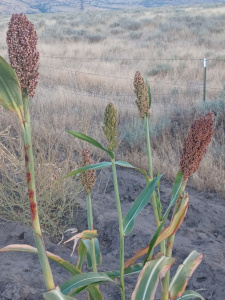
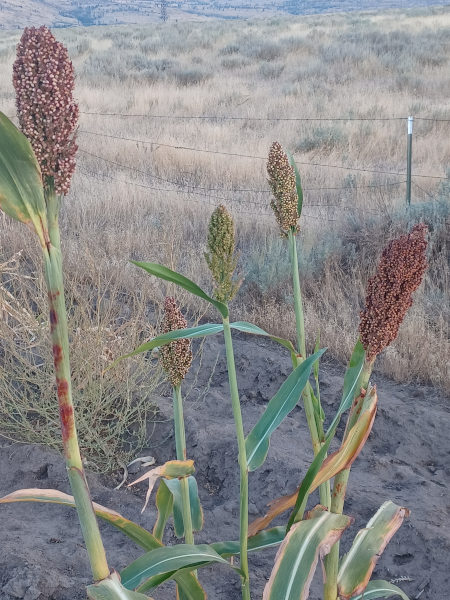
Gaolian Voskovidnyj Sorghum / 2024
|
If anyone can identify the insects in the photo above please leave us a message on the Contact Page. They do not seem to be doing damage and they have never stung when disturbed, they just fly/fall out of the head then return later.
Gaolian Voskovidnyj Sorghum 2025 (starchy sorghum)
We planted our own Gaolian Voskovidnyj sorghum seeds from 2024 with 2 new packets of the same variety to increase genetic diversity. All the sorghum seeds were soaked and had roots forming when planted. The home grown seeds were more vigorous and some survived while most if not all of the new seeds did not. Once established sorghum is drought tolerant, but because sorghum seeds are small it can't be planted as deeply as corn and the seedlings easily dry out before root establishment.
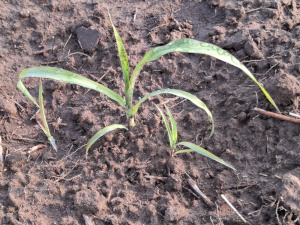
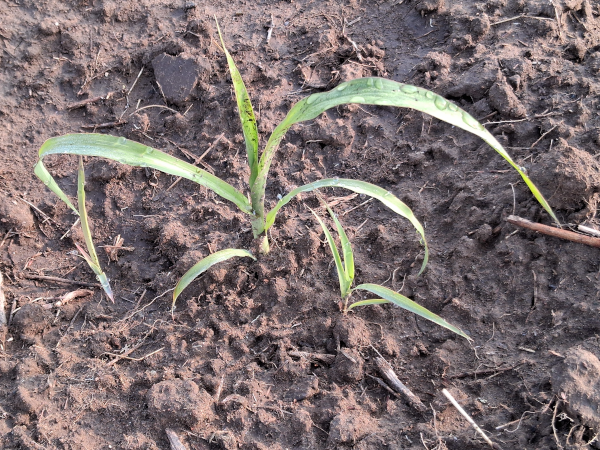
Gaolian Voskovidnyj Sorghum / Jun 23 2025
|
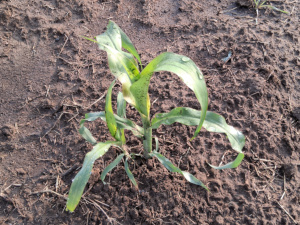
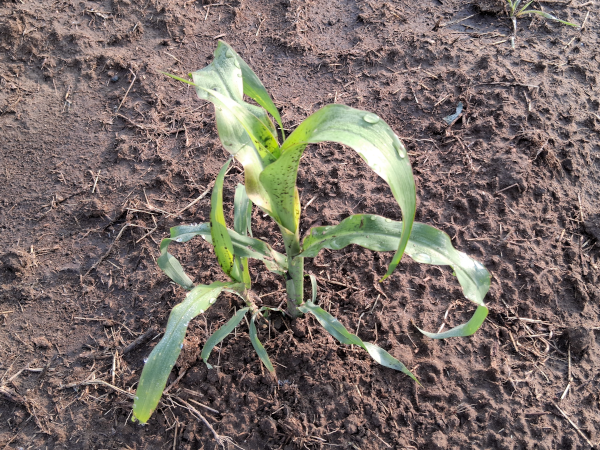
Gaolian Voskovidnyj Sorghum / Jun 23 2025
|
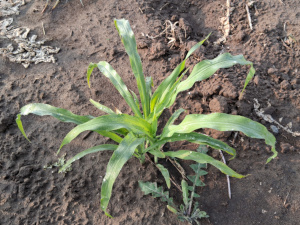
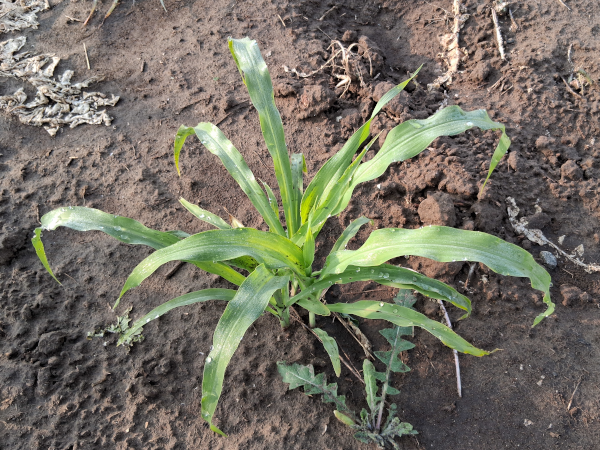
Gaolian Voskovidnyj Sorghum / Jun 23 2025
|
Seeds bought online are usually not as fresh as home grown seeds so it is better to plant a smaller plot the first year and grow seeds for the next year. Soak sorghum seeds for 12 hours before planting. Plant 1 inch deep in pots or a seed tray and when 2 -3 inches high transplant to the field. Alternatively, plant the soaked seeds 1 1/2 - 2 inches deep in moist soil and water as with any other garden crops until established (4" - 6" high). Seed harvested from these first year plants will be fresh, "plump", and full of energy.
In the second year soak the seeds from the first year for 12 hours and plant in moist soil 1.5 - 2 inches deep, with 5 - 10 seeds per hill and hills 3 x 3 ft or 3 x 6 ft. apart. When a few inches high thin to 2-3 plants per hill. Based on our tests with sorghum in 2024 we expect dryland sorghum will need 2 - 4 square feet per plant and produce several seed heads per hill.
If not crowded sorghum can yield 5 or more seeds heads or 1/2 lb. per plant. Commercial sorghum is planted 40,000 plants per acre or 1.09 square feet per plant with a yield of 0.11 lbs per plant. A reasonable estimate is that hills planted 3 x 3 ft. will produce 0.33 lbs - 0.5 lbs or more per hill.
Under favorable conditions plants adjust and produce more per plant. Single plants at lower densities can make multiple tillers increasing per plant yields several times. Use our Corn Spacing and Yield Calculator to come up with spacing and yield estimates.
Drought Tolerant Hopi Corn Seeds
Dryland Hopi Corn 2025
Dryland Hopi Corn 2024
Dryland Hopi Corn Experiment
Winter Wheat 2023